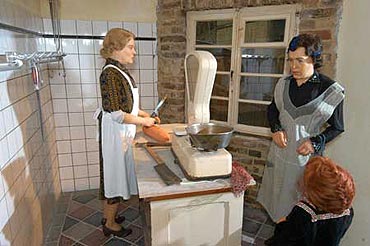Schrift: größer/kleiner
Inhaltsverzeichnis
Sie sind hier: WirRheinländer > english version > The Exhibition > Scenes > Butcher’s shop
Butcher's shop – 1947

The supply of food for the population was in a catastrophic state. Shops had no wares. The black market controlled the economy. There were food-stamps, but the baker's, grocer's and butcher's shops were empty of products to buy. This rationing system was intended to ensure the provision of basic supplies to the population. Beyond that, further needs could be satisfied on the black market. Butcher's shops still had no meat. When it was possible, animals were secretly "slaughtered illegally", so that the meat passed "under the counter" to those with good connections and those who could offer interesting objects in exchange.
"On the black market, which was a place of bartering, American cigarettes were the leading currency. Prices on the black market were much higher than the official prices for all goods. In 1947 one litre of cooking-oil, if you could find any, cost 2.50 Reichsmarks; on the black market you couldn't get one for less than 150 Reichsmarks. In the big cities the black market had grown to such an extent that today it is estimated to have accounted for one quarter of all goods traded in the post-war era."
(Thomas-Ziegler, Sabine: Mer bruche nit mih zo verdunkele. Museumsmagazin 1998, S. 25, Kommern 1998.)


